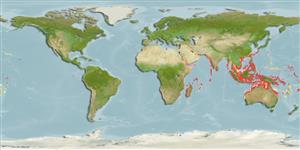Teleostei (teleosts) >
Eupercaria/misc (Various families in series Eupercaria) >
Gerreidae (Mojarras)
Etymology: Gerres: Latin, gerres = a kind of anchovies; cited by Plinius.
More on author: Cuvier.
Environment: milieu / climate zone / depth range / distribution range
Ecology
Marine; reef-associated; depth range 0 - 50 m (Ref. 86942). Tropical; 30°N - 36°S, 19°E - 165°W
Indo-Pacific: Red Sea and East Africa to Samoa and Tonga, north to the Ryukyu Islands, south to New Caledonia.
Size / Weight / Age
Maturity: Lm ? range ? - ? cm
Max length : 30.0 cm SL male/unsexed; (Ref. 1602); common length : 15.0 cm TL male/unsexed; (Ref. 2871)
Dorsal spines (total): 9; Dorsal soft rays (total): 10; Anal spines: 3; Anal soft rays: 7. Scales between 5th dorsal fin spine base and lateral line, 4-4.5. Upper jaw extending almost to the level of anterior margin of dermal eye opening. Second dorsal fin spine longest, 19-26% of SL (mean 23%). Caudal fin dusky (rarely with dark distal margin); lower edge of lower caudal fin hyaline. Dusky stripes absent or very indistinct along scale rows above lateral line (sometimes 4-9 slightly oblique dusky bands in specimens less than about 10 cm SL); 4-9 slightly oblique dusky bands or columns of ovoid dark spots (rarely brownish) immediately below lateral line, but more obvious in preserved or stressed live specimens (Ref. 41108). Adult body plain silver; may have faint dusky bars especially juveniles. Body elongate, depth max 2.8-3.3 in SL. Preopercle lower flange scaleless. Caudal fin forked deeply and with long lobes; pectoral fins do not reach beyond level of anus. (Ref. 90102)
Prefers coralline areas (Ref. 30573). Migrates to specific sandy areas near outer reef edge to spawn in late afternoons during full moon. Feeds on small benthic organisms living on sandy bottoms (Ref. 3409, 48635). In Palau, migrates to specific sandy spots near the outer reef edge to spawn in late afternoons around full moon (Ref. 37816). Forms schools. Feeds on small invertebrates found in the sand. Marketed fresh (Ref. 12915).
Life cycle and mating behavior
Maturities | Reproduction | Spawnings | Egg(s) | Fecundities | Larvae
Myers, R.F., 1991. Micronesian reef fishes. Second Ed. Coral Graphics, Barrigada, Guam. 298 p. (Ref. 1602)
IUCN Red List Status (Ref. 130435)
Threat to humans
Harmless
Human uses
Fisheries: commercial
Tools
Special reports
Download XML
Internet sources
Estimates based on models
Preferred temperature (Ref.
123201): 24.9 - 29.3, mean 28.5 °C (based on 3192 cells).
Phylogenetic diversity index (Ref.
82804): PD
50 = 0.5000 [Uniqueness, from 0.5 = low to 2.0 = high].
Bayesian length-weight: a=0.00977 (0.00553 - 0.01726), b=3.01 (2.87 - 3.15), in cm total length, based on LWR estimates for this species & Genus-body shape (Ref.
93245).
Trophic level (Ref.
69278): 3.5 ±0.37 se; based on food items.
Resilience (Ref.
120179): Medium, minimum population doubling time 1.4 - 4.4 years (Preliminary K or Fecundity.).
Fishing Vulnerability (Ref.
59153): Low to moderate vulnerability (27 of 100).
Climate Vulnerability (Ref.
125649): High to very high vulnerability (70 of 100).
Nutrients (Ref.
124155): Calcium = 58.2 [28.7, 93.5] mg/100g; Iron = 0.585 [0.283, 0.984] mg/100g; Protein = 19.3 [17.4, 21.1] %; Omega3 = 0.148 [0.085, 0.241] g/100g; Selenium = 30.7 [18.2, 52.9] μg/100g; VitaminA = 80.7 [22.0, 224.5] μg/100g; Zinc = 1.23 [0.85, 1.73] mg/100g (wet weight);
